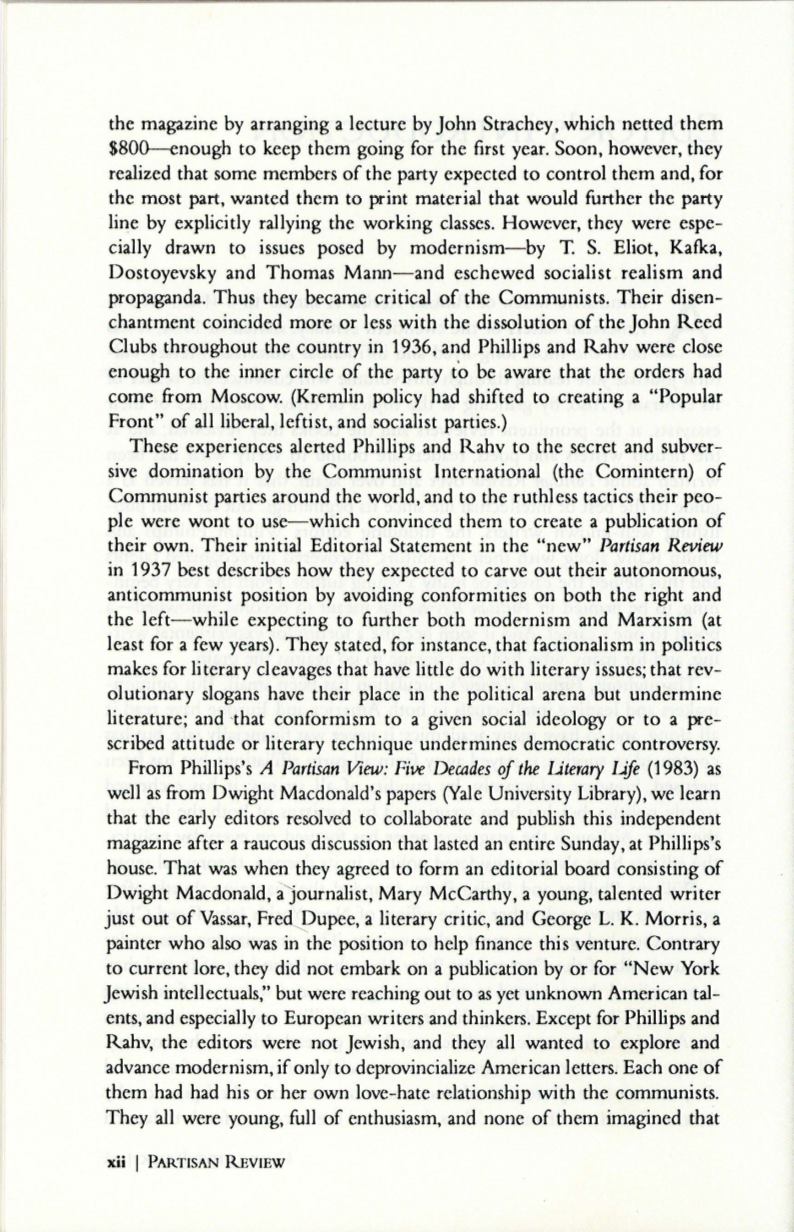

the magazine by arranging a lecture by John Strachey, which netted them
S800--enough to keep them going for the first year. Soon, however, they
realized that some members of the party expected to control them and, for
the most part, wanted them to print material that would further the party
line by explicitly rallying the working classes. However, they were espe–
cially drawn to issues posed by modernism- by
T.
S. Eliot, Kafka,
Dostoyevsky and Thomas Mann- and eschewed socialist realism and
propaganda. Thus they became critical of the Communists. Their disen–
chantment coincided more or less with the dissolution of the John Reed
Clubs throughout the country in 1936, and Phillips and Rahv were close
enough to the inner circle of the party to be aware that the orders had
come from Moscow. (Kremlin policy had shifted to creating a "Popular
Front" of all liberal, leftist, and socialist parties.)
These experiences alerted Phillips and Rahv to the secret and subver–
sive domination by the Communist International (the Comintern) of
Communist parties around the world, and to the ruthless tactics their peo–
ple were wont to use-which convinced them to create a publication of
their own. Their initial Editorial Statement in the "new"
Partisan Review
in 1937 best describes how they expected to carve out their autonomous,
anticommunist position by avoiding conformities on both the right and
the left- while expecting to further both modernism and Marxism (at
least for a few years). They stated, for instance, that factionalism in politics
makes for literary cleavages that have little do with literary issues; that rev–
olutionary slogans have their place in the political arena but undermine
literature; and -that conformism to a given social ideology or to a pre–
scribed attitude or literary technique undermines democratic controversy.
From Phillips's
A Partisan View: Five Decades of the Uterary
Life
(1983) as
well as from Dwight Macdonald's papers (Yale University Library), we learn
that the early editors resolved to collaborate and publish this independent
magazine after a raucous discussion that lasted an entire Sunday, at Phillips's
house. That was when they agreed to form an editorial board consisting of
Dwight Macdonald, ajournalist, Mary McCarthy, a young, talented writer
just out of Vassar, Frecl_pupee, a literary critic, and George
L.
K. Morris, a
painter who also was in the position to help finance this venture. Contrary
to current lore, they did not embark on a publication by or for "New York
Jewish intellectuals," but were reaching out to as yet unknown American tal–
ents, and especially to European writers and thinkers. Except for Phillips and
Rahv, the editors were not Jewish, and they all wanted to explore and
advance modernism, if only to deprovincialize American letters. Each one of
them had had his or her own love-hate relationship with the communists.
They all were young, full of enthusiasm, and none of them imagined that
xii
I
PARTISAN REVIEW









